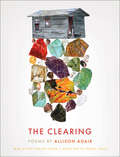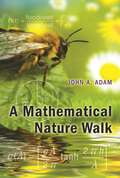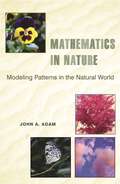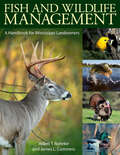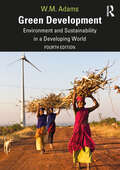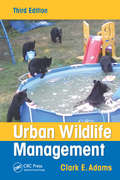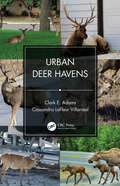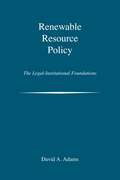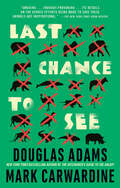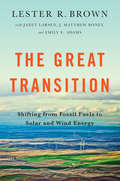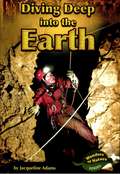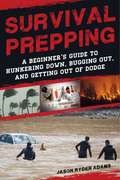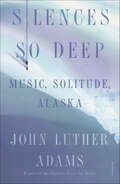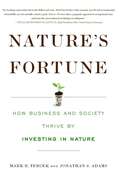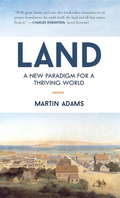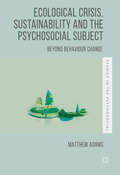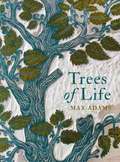- Table View
- List View
The Clearing: Poems (Max Ritvo Poetry Prize Ser.)
by Allison AdairA poetry debut that&’s &“a lush, lyrical book about a world where women are meant to carry things to safety and men leave decisively&” (Henri Cole). Luminous and electric from the first line to the last, Allison Adair&’s debut collection navigates the ever-shifting poles of violence and vulnerability with a singular incisiveness and a rich imagination. The women in these poems live in places that have been excavated for gold and precious ores, and they understand the nature of being hollowed out. From the midst of the Civil War to our current era, Adair charts fairy tales that are painfully familiar, never forgetting that violence is often accompanied by tenderness. Here we wonder, &“What if this time instead of crumbs the girl drops / teeth, her own, what else does she have&”?The Clearing knows the dirt beneath our nails, both alone and as a country, and pries it gently loose until we remember something of who we are, &“from before . . . from a similar injury or kiss.&” There is a dark beauty in this work, and Adair is a skilled stenographer of the silences around which we orbit. Described by Henri Cole as &“haunting and dirt caked,&” her unromantic poems of girlhood, nature, and family linger with an uncommon, unsettling resonance.Winner of the 2019 Max Ritvo Poetry PrizePraise for The Clearing &“A dark and bodily nod to folk- and fairy-tale energy.&” —Boston Globe &“The poems in Adair&’s debut draw on folklore and the animal world to assert feminist viewpoints and mortal terror in lush musical lines, as when &“A fat speckled spider sharpens / in the shoe of someone you need.&” —New York Times Book Review, &“New & Noteworthy Poetry&” &“Like Grimms&’ fairy tales, Adair&’s poems are dark without being bleak, hopeless, or disturbing. Readers will find the collections lush language and provocative imagery powerfully resonant.&” —Publishers Weekly (Starred Review)
A Mathematical Nature Walk
by John AdamHow heavy is that cloud? Why can you see farther in rain than in fog? Why are the droplets on that spider web spaced apart so evenly? If you have ever asked questions like these while outdoors, and wondered how you might figure out the answers, this is a book for you. An entertaining and informative collection of fascinating puzzles from the natural world around us, A Mathematical Nature Walk will delight anyone who loves nature or math or both. John Adam presents ninety-six questions about many common natural phenomena--and a few uncommon ones--and then shows how to answer them using mostly basic mathematics. Can you weigh a pumpkin just by carefully looking at it? Why can you see farther in rain than in fog? What causes the variations in the colors of butterfly wings, bird feathers, and oil slicks? And why are large haystacks prone to spontaneous combustion? These are just a few of the questions you'll find inside. Many of the problems are illustrated with photos and drawings, and the book also has answers, a glossary of terms, and a list of some of the patterns found in nature. About a quarter of the questions can be answered with arithmetic, and many of the rest require only precalculus. But regardless of math background, readers will learn from the informal descriptions of the problems and gain a new appreciation of the beauty of nature and the mathematics that lies behind it.
Mathematics in Nature: Modeling Patterns in the Natural World
by John AdamFrom rainbows, river meanders, and shadows to spider webs, honeycombs, and the markings on animal coats, the visible world is full of patterns that can be described mathematically. Examining such readily observable phenomena, this book introduces readers to the beauty of nature as revealed by mathematics and the beauty of mathematics as revealed in nature. Generously illustrated, written in an informal style, and replete with examples from everyday life, Mathematics in Nature is an excellent and undaunting introduction to the ideas and methods of mathematical modeling. It illustrates how mathematics can be used to formulate and solve puzzles observed in nature and to interpret the solutions. In the process, it teaches such topics as the art of estimation and the effects of scale, particularly what happens as things get bigger. Readers will develop an understanding of the symbiosis that exists between basic scientific principles and their mathematical expressions as well as a deeper appreciation for such natural phenomena as cloud formations, halos and glories, tree heights and leaf patterns, butterfly and moth wings, and even puddles and mud cracks. Developed out of a university course, this book makes an ideal supplemental text for courses in applied mathematics and mathematical modeling. It will also appeal to mathematics educators and enthusiasts at all levels, and is designed so that it can be dipped into at leisure.
Austral Ark
by Adam Stow Norman Maclean Gregory I. Holwell Adam Stow Norman MacleanAustralia and New Zealand are home to a remarkable and unique assemblage of flora and fauna. Sadly though, by virtue of their long isolation, and a naïve and vulnerable biota, both countries have suffered substantial losses to biodiversity since European contact. Bringing together the contributions of leading conservation biologists, Austral Ark presents the special features and historical context of Austral biota, and explains what is being conserved and why. The threatening processes occurring worldwide are discussed, along with the unique conservation problems faced at regional level. At the same time, the book highlights many examples of conservation success resulting from the innovative solutions that have been developed to safeguard native species and habitats in both New Zealand and Australia. Austral Ark fills an important gap regarding wildlife gains and declines, and how best to take conservation forward to keep this extraordinary area of the world thriving.
Fish and Wildlife Management: A Handbook for Mississippi Landowners
by Adam T. Rohnke and James L. CumminsFeaturing over five hundred illustrations and forty tables, this book is a collection of in-depth discussions by a tremendous range of experts on topics related to wildlife and fisheries management in Mississippi. Beginning with foundational chapters on natural resource history and conservation planning, the authors discuss the delicate balance between profit and land stewardship. A series of chapters about the various habitat types and the associated fish and wildlife populations that dominate them follow. Several chapters expand on the natural history and specific management techniques of popular species of wildlife, including white-tailed deer, eastern wild turkey, and other species. Experts discuss such special management topics as supplemental, wildlife-food planting, farm pond management, backyard habitat, nuisance animal control, and invasive plant species control. Leading professionals who work every day in Mississippi with landowners on wildlife and fisheries management created this indispensable book. The up-to-date and applicable management techniques discussed here can be employed by private landowners throughout the state. For those who do not own rural lands but have an interest in wildlife and natural resources, this book also has much to offer. Residents of urban communities interested in creating a wildlife-friendly yard will delight in the backyard habitat chapter specifically written for them. Whether responsible for one-fourth of an acre or two thousand, landowners will find this handbook to be an incalculable aid on their journey to good stewardship of their Mississippi lands.
Green Development: Environment and Sustainability in a Developing World
by Bill AdamsThe concept of sustainability lies at the core of the challenge of environment and development, and the way governments, business and environmental groups respond to it. Green Development provides a clear and coherent analysis of sustainable development in both theory and practice. Green Development explores the origins and evolution of mainstream thinking about sustainable development and offers a critique of the ideas behind them. It draws a link between theory and practice by discussing the nature of the environmental degradation and the impacts of development. It argues that, ultimately, ‘green’ development has to be about political economy, about the distribution of power, and not about environmental quality. Its focus is strongly on the developing world. The fourth edition retains the broad structure of previous editions, but has been updated to reflect advances in ideas and changes in international policy. Greater attention has been given to the political ecology of development, and market-based and neoliberal environmentalism, and degrowth. This fully revised edition discusses: the origins of thinking about sustainability and sustainable development, and its evolution to the present day. the ideas that dominate mainstream sustainable development (including natural capital, the green economy, market environmentalism and ecological modernization). critiques of mainstream ideas and of neoliberal framings of sustainability, and alternative ideas about sustainability that challenge ‘business as usual’ thinking, such as arguments about limits to growth, and calls for degrowth. the dilemmas of sustainability in the context forests, desertification, food and faming, biodiversity conservation and dam construction. the challenge of policy choices about sustainability, particularly between reformist and radical responses to the contemporary global dilemmas. Green Development offers clear insights into the challenges of environmental sustain- ability, and social and economic development. It is unique in offering a synthesis of theoretical ideas on sustainability and in its coverage of the extensive literature on environment and development around the world. The book has proved its value to generations of students as an authoritative, thought-provoking and readable guide to the field of sustainable development.
Urban Wildlife Management
by Clark E. AdamsWinner of the 2018 TWS Wildlife Publication Awards in the authored book category Urban development is one of the leading worldwide threats to conserving biodiversity. In the near future, wildlife management in urban landscapes will be a prominent issue for wildlife professionals. This new edition of Urban Wildlife Management continues the work of its predecessors by providing a comprehensive examination of the issues that increase the need for urban wildlife management, exploring the changing dynamics of the field while giving historical perspectives and looking at current trends and future directions. The book examines a range of topics on human interactions with wildlife in urbanized environments. It focuses not only on ecological matters but also on political, economic, and societal issues that must be addressed for successful management planning. This edition features an entirely new section on urban wildlife species, including chapters on urban communities, herpetofauna, birds, ungulates, mammals, carnivores, and feral and introduced species. The third edition features Five new chapters 12 updated chapters Four new case studies Seven new appendices and species profiles 90 new figures A comprehensive analysis of terrestrial vertebrate locations by state and urban observations Each chapter opens with a set of key concepts which are then examined in the following discussions. Suggested learning experiences to enhance knowledge conclude each chapter. The species profiles cover not only data about the animal concerned but also detail significant current management issues related to the species. An updated and expanded teaching tool, Urban Wildlife Management, Third Edition identifies the challenges and opportunities facing wildlife in urban communities as well as factors that promote or threaten their presence. It gives both students and professionals a solid grounding in the required fundamental ecological principles for understanding the effects of human-made environments on wildlife.
Urban Deer Havens
by Clark E. Adams Cassandra LaFleur VillarrealUrban Deer Havens consists of a thorough examination of selected cervid (deer) species that are known to inhabit urban communities in the United States. The deer species that are included in this presentation consisted of white-tailed (Odocoileus virginianus), Key deer (O. v. clavium), moose (Alces alces), elk (Cervus elaphus), mule (Odocoileus hemionus), and black-tailed deer (O. h. columbianus). This book is the first attempt to examine the similarities and differences in those factors that allow the selected cervids to exist and thrive in urban habitats. This information has never been collected, collated, reviewed, and published under one cover document. Yet, all five are known to inhabit urban communities within their geographic range. The lack of information concerning several important examples of urban cervids in conjunction with a proliferation of information on white-tailed deer only is an incomplete and biased presentation. This book is the first comprehensive source of information on urban deer management, which includes a broad assemblage of urban cervids. The overall objective of this book is to provide a more holistic examination of urban cervids. For example, it examines the similarities and differences of the environmental impacts, management strategies, and human dimensions considerations concerning urban cervids in general, and using specific examples. Urban Deer Havens features four chapters that include: Urban deer census techniques and population dynamics Comprehensive tables that review urban community deer management plans National and state-wide estimates the five selected cervids Laws and regulations concerning urban deer Lethal and nonlethal management options for managing deer Steps for managing urban deer populations Examples of urban deer management efforts
Renewable Resource Policy: The Legal-Institutional Foundations
by David A. AdamsRenewable Resource Policy is a comprehensive volume covering the history, laws, and important national policies that affect renewable resource management. The author traces the history of renewable natural resource policy and management in the United States, describes the major federal agencies and their functions, and examines the evolution of the primary resource policy areas. The book provides valuable insight into the often neglected legal, administrative, and bureaucratic aspect of natural resource management. It is a definitive and essential source of information covering all facets of renewable resource policy that brings together a remarkable range of information in a coherent, integrated form.
Last Chance to See
by Douglas Adams Mark Carwardine"Very funny and moving...The glimpses of rare fauna seem to have enlarged [Adams'] thinking, enlivened his world; and so might the animals do for us all, if we were to help them live."THE WASHINGTON POST BOOK WORLDJoin bestselling author Douglas Adams and zooligist Mark Carwardine as they take off around the world in search of exotic, endangered creatures. Hilarious and poignant--as only Douglas Adams can be--LAST CHANCE TO SEE is an entertaining and arresting odyssey through the Earth's magnificent wildlife galaxy.From the Trade Paperback edition.
The Great Transition: Shifting from Fossil Fuels to Solar and Wind Energy
by Emily Adams Janet Larsen Lester R. Brown J Matthew RoneyThe great energy transition from fossil fuels to renewable sources of energy is under way. As oil insecurity deepens, the extraction risks of fossil fuels rise, and concerns about climate instability cast a shadow over the future of coal, a new world energy economy is emerging. The old economy, fueled by oil, natural gas, and coal is being replaced with one powered by wind, solar, and geothermal energy. The Great Transition details the accelerating pace of this global energy revolution. As many countries become less enamored with coal and nuclear power, they are embracing an array of clean, renewable energies. Whereas solar energy projects were once small-scale, largely designed for residential use, energy investors are now building utility-scale solar projects. Strides are being made: some of the huge wind farm complexes under construction in China will each produce as much electricity as several nuclear power plants, and an electrified transport system supplemented by the use of bicycles could reshape the way we think about mobility.
Diving Deep into the Earth (Fountas & Pinnell LLI Purple #Level T)
by Jacqueline AdamsDiving Deep into the Earth by Jacqueline Adams
Made in the Forest (Fountas & Pinnell Classroom, Guided Reading)
by Jacqueline AdamsNIMAC-sourced textbook. Into the Forest. This is the great Amazon rainforest. What grows there? Who lives there? Come in and see!
Surprising Sand (Fountas & Pinnell Classroom, Guided Reading)
by Jacqueline AdamsNIMAC-sourced textbook. Simple Sand? Sand seems simple and plain. But read on and discover what makes sand much more unique than it may seem.
Treasure from the Sea (Fountas & Pinnell LLI Red #Level J)
by Jacqueline AdamsAround the world, people hunt for a treasure called sea glass. This treasure used to be trash!
Underwater Art (Fountas & Pinnell Classroom, Guided Reading Grade 4)
by Jacqueline AdamsART TO THE RESCUE One of the largest coral reef systems in the world was in danger of being damaged beyond repair. The solution? A unique museum, dreamed up by an environmentalist, a businessman, and an artist, all working together. NIMAC-sourced textbook
A Walk in the Woods (Fountas & Pinnell Classroom, Guided Reading)
by Jacqueline AdamsNIMAC-sourced textbook
Wanted: Lost Amphibians (Fountas & Pinnell LLI Purple #Level T)
by Jacqueline AdamsMany of the world's frogs went missing. Some hadn't been seen in more than a hundred years. Were they gone forever? Scientists went a worldwide hunt to find out.
Survival Prepping: A Guide to Hunkering Down, Bugging Out, and Getting Out of Dodge
by Jason Ryder AdamsFood, Water, First Aid, and Self-Defense Tips for Surviving Natural Disasters, Extreme Weather, Pandemics, Biological Threats, Terrorist Attacks, and Riots It could be a fire, flood, hurricane, tornado, or hailstorm. Financial system collapse or bioterrorism. Governmental shutdown or societal breakdown. The world is full of possible threats, and they seem to be coming at us from all sides these days. Jason Ryder Adams covers everything you need to know prepare your home, keep your family safe, and get ready to leave if the worst happens. You’ll learn how to: Prep with children and pets (and do test runs ahead of time)Plan for staying put, sealing yourself in, and leaving depending on the threatChoose and protect a safe location and develop an escape routeDefend your family with self-defense training and firearmsPut together a 72-hour emergency kit, bug-out bag, and first aid kit So don’t panic—prepare! Prepping today is for everyone. Survival Prepping is written for ordinary folks who want to get started on preparing for the worst. Adams shares bug-out plans for every scenario, safety tips, and invaluable checklists for acquiring the right supplies for emergency situations. Survival Prepping will help you ensure your family survives—and hopefully thrives—should a disaster strike.
Silences So Deep: Music, Solitude, Alaska
by John Luther Adams"[An] illuminating memoir." —Corinna da Fonseca-Wollheim, The New York TimesThe story of a composer's life in the Alaskan wilderness and a meditation on making art in a landscape acutely threatened by climate changeIn the summer of 1975, the composer John Luther Adams, then a twenty-two-year-old graduate of CalArts, boarded a flight to Alaska. So began a journey into the mountains, forests, and tundra of the far north—and across distinctive mental and aural terrain—that would last for the next forty years. Silences So Deep is Adams’s account of these formative decades—and of what it’s like to live alone in the frozen woods, composing music by day and spending one’s evenings with a raucous crew of poets, philosophers, and fishermen. From adolescent loves—Edgard Varèse and Frank Zappa—to mature preoccupations with the natural world that inform such works as The Wind in High Places, Adams details the influences that have allowed him to emerge as one of the most celebrated and recognizable composers of our time. Silences So Deep is also a memoir of solitude enriched by friendships with the likes of the conductor Gordon Wright and the poet John Haines, both of whom had a singular impact on Adams’s life. Whether describing the travails of environmental activism in the midst of an oil boom or midwinter conversations in a communal sauna, Adams writes with a voice both playful and meditative, one that evokes the particular beauty of the Alaskan landscape and the people who call it home.Ultimately, this book is also the story of Adams’s difficult decision to leave a rapidly warming Alaska and to strike out for new topographies and sources of inspiration. In its attentiveness to the challenges of life in the wilderness, to the demands of making art in an age of climate crisis, and to the pleasures of intellectual fellowship, Silences So Deep is a singularly rich account of a creative life.
Nature's Fortune: How Business and Society Thrive by Investing in Nature
by Jonathan S. Adams Mark R. TercekWhat is nature worth? The answer to this question-which traditionally has been framed in environmental terms-is revolutionizing the way we do business. In Nature’s Fortune, Mark Tercek, CEO of The Nature Conservancy and former investment banker, and science writer Jonathan Adams argue that nature is not only the foundation of human well-being, but also the smartest commercial investment any business or government can make. The forests, floodplains, and oyster reefs often seen simply as raw materials or as obstacles to be cleared in the name of progress are, instead, as important to our future prosperity as technology or law or business innovation. Who invests in nature, and why? What rates of return can it produce? When is protecting nature a good investment? With stories from the South Pacific to the California coast, from the Andes to the Gulf of Mexico and even to New York City, Nature’s Fortune shows how viewing nature as green infrastructure allows for breakthroughs not only in conservation-protecting water supplies; enhancing the health of fisheries; making cities more sustainable, livable and safe; and dealing with unavoidable climate change-but in economic progress, as well. Organizations obviously depend on the environment for key resources-water, trees, and land. But they can also reap substantial commercial benefits in the form of risk mitigation, cost reduction, new investment opportunities, and the protection of assets. Once leaders learn how to account for nature in financial terms, they can incorporate that value into the organization’s decisions and activities, just as habitually as they consider cost, revenue, and ROI. Such a rethinking of "natural capital”-nature as a quantifiable asset-can not only increase profitability, but provide crucial protection against the kinds of climate change-driven phenomena-like devastating drought and hundred-year floods-that are no longer the stuff of speculation. A must-read for business leaders, CEOs, investors, and environmentalists alike, Nature’s Fortune offers an essential guide to the world’s economic-and environmental-well-being.
Land
by Martin AdamsWhat if we lived in a world where everyone had enough? A world where everyone mattered and where people lived in harmony with nature? What if the solution to our economic, social, and ecological problems was right underneath our feet? Land has been sought after throughout human history. Even today, people struggle to get onto the property ladder and view real estate as an important way to build wealth. Yet, as the reader will discover through this book, the act of owning land--and our urge to profit from it--causes economic booms and busts, social and cultural decline, and environmental devastation. Land: A New Paradigm for a Thriving World introduces a radically new economic model that ensures a more fair and abundant reality for everyone. It is a book for those who dream of a better world, for themselves and future generations.Table of ContentsIntroduction Part I: The Cost of Ignorance1. The Production of Wealth 2. The Value of Location3. The Free Market4. Social Decline5. Business Recessions6. Ecocide7. Earth, Our HomePart II: A New Paradigm for a Thriving World8. Restoring Communities9. Keep What You Earn, Pay for What You Use10. Local Autonomy11. Affordable Housing12. Thriving Cities13. Sustainable Farming14. The Price of Peace15. A New ParadigmEpilogue: A Personal NoteAppendix: The Math Behind the ScienceReferences & Suggestions for Further ReadingEndnotesIndexFrom the Trade Paperback edition.ng and contagious passion. The second part explores an economic solution so radical yet so easily understandable that the reader cannot help but be transformed.Table of ContentsIntroduction 1Part I: The Cost of Ignorance1. The Production of Wealth 72. The Value of Location 103. The Free Market 134. Social Decline5. Business Recessions6. Ecocide7. Earth, Our Home8. Déjà Vu, AgainPart II: A Humanitarian Perspective9. Restoring Communities10. Keep What You Earn, Pay for What You Use11. Local Autonomy12. Affordable Housing13. Thriving Cities14. Sustainable Farming15. The Price of Peace16. Lasting Prosperity17. A New ParadigmEpilogue: A Personal NoteAcknowledgmentsAppendix: The Math Behind the ScienceReferences & Suggestions for Further ReadingEndnotes
Ecological Crisis, Sustainability and the Psychosocial Subject
by Matthew AdamsThis book draws on recent developments across a range of perspectives including psychoanalysis, narrative studies, social practice theory, posthumanism and trans-species psychology, to establish a radical psychosocial alternative to mainstream understanding of 'environmental problems'. Only by addressing the psychological and social structures maintaining unsustainable societies might we glimpse the possibility of genuinely sustainable future. The challenges posed by the reality of human-caused 'environmental problems' are unprecedented. Understanding how we respond to knowledge of these problems is vital if we are to have a hope of meeting this challenge. Psychology and the social sciences have been drafted in to further this understanding, and inform interventions encouraging sustainable behaviour. However, to date, much of psychology has appeared happy to tinker with individual behaviour change, or encourage minor modifications in the social environment aimed at 'nudging' individual behaviour. As the ecological crisis deepens, it is increasingly recognised that mainstream understandings and interventions are inadequate to the collective threat posed by climate change and related ecological crises.
Trees of Life
by Max AdamsAn informative, richly illustrated book about eighty of the world’s most important and remarkable treesOur planet is home to some three trillion trees—roughly four hundred for every person on Earth. In Trees of Life, Max Adams selects, from sixty thousand extant species, eighty remarkable trees through which to celebrate the richness of humanity’s relationship with trees, woods, and forests.In a sequence of informative and beautifully illustrated portraits, divided between six thematic sections, Adams investigates the trees that human cultures have found most useful across the world and ages: trees that yield timber and other materials of immense practical value, trees that bear edible fruits and nuts, trees that deliver special culinary ingredients and traditions, and trees that give us dyes, essences, and medicines. In a section titled “Supertrees,” Adams considers trees that have played a pivotal role in maintaining natural and social communities, while a final section, “Trees for the Planet,” looks at a group of trees so valuable to humanity that they must be protected at all costs from loss.From the apple to the oak, the logwood to the breadfruit, and the paper mulberry to the Dahurian larch, these are trees that offer not merely shelter, timber, and fuel but also drugs, foods, and fibers. Trees of Life presents a plethora of fascinating stories about them.
